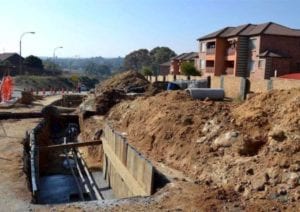The South African Federation of Civil Engineering Contractors (SAFCEC) encourages and supports its members to follow strict protocol and procedures when working on municipal property.
Recently, the Ekurhuleni Metropolitan Municipality took a tough stance against contractors, whose alleged negligence resulted in damage to council infrastructure and inconveniencing residents and businesses, through subsequent service delivery disruptions. “SAFCEC agrees that local authorities should take action against contractors who negligently cause damage to municipal property. The onus rests on the contractor to act within strict parameters as set out in the Scope of Works, Contract and other stipulated regulations,” states James Flint, national Safety, Health, Environment, Risk and Quality (SHERQ) advisor at SAFCEC. “It must be said, however, that SAFCEC receives regular feedback from its members about various other factors that influence unintended damage to municipal infrastructure. Although there are contractors in the industry that may take shortcuts, it should be noted that contractors have vast experience in conducting work on municipal property, and that they follow the appropriate construction practices to provide professional construction services to local authorities. Contractors can, therefore, not solely be held liable for infrastructure damage and local authorities need to work with contractors in supplying them with the correct and accurate information on buriedinfrastructure so that damage is not caused unintentionally.” Flint continues. According to Mamikie Makoanyane, director of Patsimo Civils and a member of SAFCEC, local contractors are confronted with the challenge that the provided municipal drawings do not always correlate with reality. “When a contractor commences with a construction project, the client, usually the municipal engineer, provides the As Built Drawings which indicate the location of the municipal infrastructure. From my own experience, there is often a mismatch between the drawings received, and what we encounter underground. When digging a trench, contractors are confronted with cables that were not updated on the provided technical drawings,” says Makoanyane.There are several guidelines and interventions contractors need to follow to prevent damage to property such as applying for way leaves and digging test holes to determine whether the provided drawings correlate with the actual site conditions.
According to Makoanyane a reputable contractor needs to dig a test hole every 200 m to ensure that he or she doesn’t hit any infrastructure or underground cabling. “Although the digging of test holes may be a tedious, costly and labour intensive process, it is critical for contractors to do this, to prevent the risk of damage to municipal assets,” says Makoanyane. “If these procedures have been followed and damage still occurs, the client needs to be realistic about the preliminary drawings provided and the actual location of their own infrastructure,” she continues. As an industry association, SAFCEC makes a call to local authorities to ensure the provision of updated, accurate and precise As Built Drawings to contractors, to reduce the risk of unintended damage to council property. SAFCEC aims to raise further awareness amongst its members on this issue and encourages them to take meticulous care and follow exact procedures when excavating on municipal property. SAFCEC further urges members to keep proof of correspondence with municipalities on the location of council infrastructure, to avoid future repercussions.







